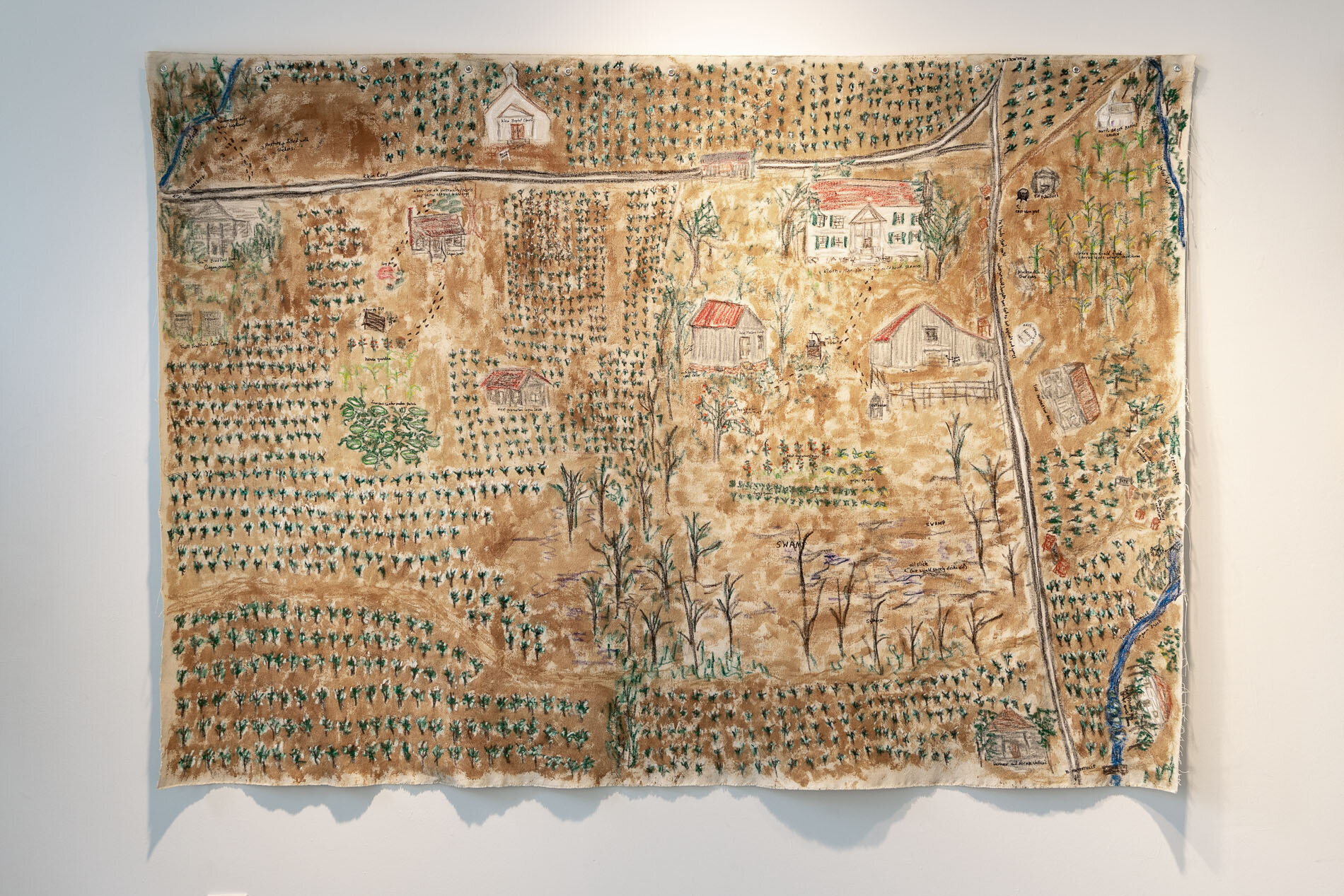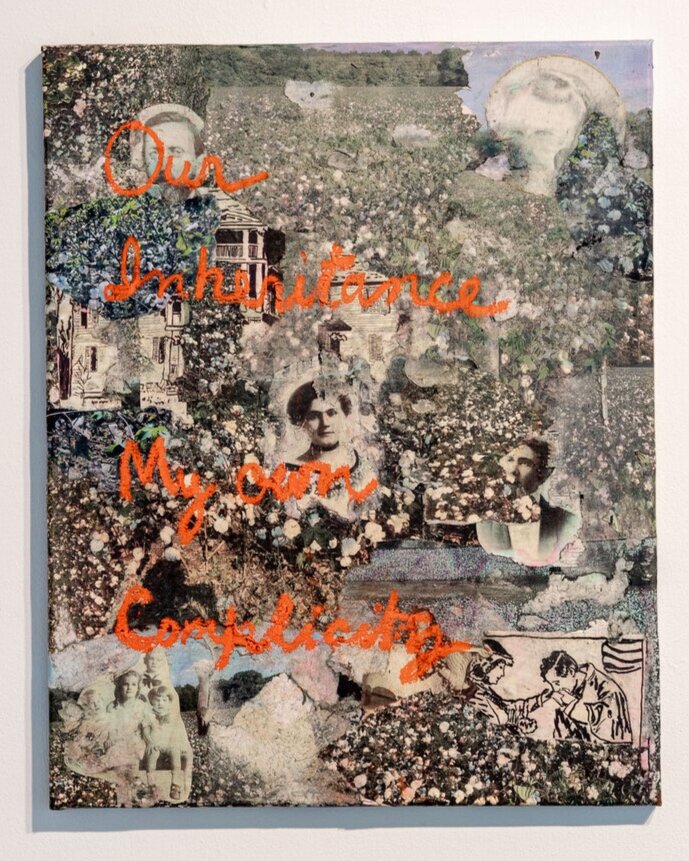Exhibition
The Alchemy of Art & Place
by Nell Gottlieb
After inheriting an antebellum plantation, artist Nell Gottlieb confronts her inheritance in a virtual exhibition and cultural center
I. The alchemy of place
In 2018, I inherited Klein, the simple rural plantation house my great-great grandfather established in 1841 in Harpersville, Alabama, which had stood vacant for 50 years. It was empty, with peeling walls and deteriorating chimneys, without any amenities except for 1930s electricity. This moment proved to be pivotal in my life and art.
My mother and I lived with my grandmother, and I had grown up going to Klein with her during the summers in the 1950s. I absorbed many stories from my grandmother and great aunts during this time, and I think that my socialization was Alabama-turn-of-the-century as much as that of the 50’s of my actual childhood. Looking back, it was lazy and bucolic, swimming every day with my friend in her family’s creek where we were baptized one summer.
The Klein House prior to restoration in 2018
Nell inspecting the interior of her ancestral home
“We share the ties that bind, a fraught history that we have come together to rethink.”
But I came back to the house in 2018, a lifetime later, with a different lens to view the place and life there. I had left Birmingham in 1962, vowing never to return. But here I was, and I was forced to re-member my past. I knew a debt had to be paid, but I wasn’t sure what or how.
That October, Theo Perkins, the first African American mayor of Harpersville and a descendant of the place, and I invited Black and white descendants to a homecoming to rededicate the Black and white family cemeteries and to have a facilitated discussion in the house over barbeque.
Soon after, we founded Klein Arts & Culture to own and preserve the house as a venue for arts, education, and cultural events that encourage us to rethink the past and to offer space for conversations around race, justice, and social change. We were committed to building a new narrative together.
Now the house, with events such as the homecomings and Migratuse Ataraxia (a dance performance that shifts the rules of representation, making enslaved people the center of the antebellum house), is alchemically transforming the community associated with Klein.
We are working together to develop histories of families from their enslavement at Klein to the Great Migration generation, thinking about who left and who stayed -- and what are their accomplishments?
Behind-the-scenes of Migratuse Ataraxia, staged at Klein and produced by the Wideman Davis Dance Company in association with the Alabama Dance Council. Film by Alabama Public Television.
The house has had its way with me as well. I no longer think of it as my house but as our Family house. Family with a capital F that incorporates descendants of all who have been enslaved on the property, of the owners, of the renters, of the sharecroppers. We share the ties that bind, a fraught history that we have come together to rethink. We work together on our genealogies, tracing shared names. And now we begin to know and trust each other as we develop plans for the future of our house.
II. The alchemy of art
The alchemy of art has also pushed me to re-member. I began making work for what became my Choked on Cotton exhibition, with porcelain wall-hung illustrations related to my childhood and to the family lore.
The first 4x6 foot unstretched canvas I made was Codex: Map of My Childhood, modeled on 16th century colonial maps from Mexico and using dirt from Klein as pigment. I relived the paths I took during the summers and what was important to me.
Codex: Map of my childhood, 2020. 48” x 76”. Gouache, oil pastel and dirt. Photograph by Nash Baker.
This brought me to a point of reckoning using the metaphor of cotton and the cotton economy in self-portraits. My figure lay supine supported by cotton plants in a field in a second dirt-pigmented canvas: on a funeral pyre? supported by cotton? held up or pressing down on those who picked the cotton? This image was burned into my mind before I painted it.
The exhibit culminated in an installation of plates with fired-on images of two matriarchs from Klein surrounded by their descendants who had come together in homecoming, making a sweep from childhood innocence through reckoning to the resolution.
Self Portrait in Cotton 2, which was not included in the exhibition.
Self Portrait in Cotton 1, 2020. 48” x 76”. Gouache, oil pastel, and dirt. Photograph by Nash Baker.
But this easy walk through was not to be. Three days after the opening, George Floyd was murdered by police using a choke-hold. Here I was, a white woman, making an exhibit called Choked on Cotton, which had a focus on my being metaphorically choked by the legacy of cotton. It became crystal clear to me that my family history of oppression in service of cotton promoted violence then and was an economic driver of the institutional racism so vividly seen in George Floyd’s death. Suddenly, I felt I had no business exhibiting my pain at the hands of cotton...
Our Inheritance My Own Complicity, 16” x 20”, collage and oil pastel, 2020. Photograph by Nash Baker.
Alchemy is the transmutation of a base metal to gold or, for humans, the process of moving toward spiritual integration or wholeness. I feel that it is at work as we, the children of the enslaved and the enslavers, come together to re-think our past and use the place where such dehumanization happened to create a shared narrative based on equality and justice.
In my own personal journey, my art practice and this process of re-membering has fused alchemically, beginning when I wrote the words “Our inheritance / My own complicity” in vermillion oil pastel over a collage made from imagery of Klein, my ancestors and the ubiquitous cotton.
And so I take my place with the others to create our future.
Contributor
NELL GOTTLIEB works in multiple media to reexamine her coming of age, white and female in the Jim Crow South. Her ongoing project, Nostos Algos, considers the pain of returning to the South after a long absence, while confronting the racist mythologies and complicated legacies of the region. Gottlieb recently completed the Block Program of the Glassell School of Art at The Museum of Fine Arts, Houston, and she has studied with many artists and craft practitioners in the U.S. and in Europe. She has shown her work in national, regional, and local juried shows and has two works in the Hobby Airport Collection. She serves as past-president of ClayHouston, has been on the board of the Visual Arts Alliance, and is a member of the Texas Sculpture Group. She holds a BA and MA (psychology) from Emory University and a PhD (sociology) from Boston University. She is professor emeritus of public health education at The University of Texas at Austin, where she taught from 1980-2011. A native of Alabama, she moved to Texas in 1980.









